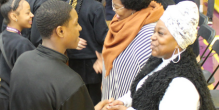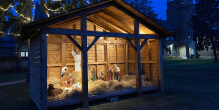STEAM Education Expands at CDH
Reprinted from Traditions, Winter 2021-22
March 3, 2022
Editor's Note: The official name of our new space is the Ryan STEM Center. We use STEAM (Science, Technology, Engineering, Art, Math) to refer to the curricular area.
Down a gleaming hallway next to the Commons, Raiders are welcomed to a brand new space designed to spark their imaginations.
The Ryan STEM Center — comprised of a Design Lab and an Innovation Lab — puts state-of-the-art technology at the fingertips of all of our students and gives them the space to explore. This new space, made possible by a generous gift from Ron '62 and Patty Ryan, is the physical manifestation of our dedication to STEAM education.
The Ryan STEM Center is centrally located on campus and managed by our STEAM Coordinator, Ellen Schafer ’10. It’s a creative space intended to be used by our entire faculty and students — no matter the subject area. While the Ryan STEM Center has obvious tie-ins to science, math, and technology, the unique vision of the CDH space is to support all curricular areas, with opportunities for cross-curricular projects, co-curricular activities, such as Robotics and an Engineering Club, and so much more. Schafer is on hand to help teachers develop curriculum that takes advantage of this new resource.
“It’s my job to work with teachers to envision how we can marry these tools and materials with their curriculum, especially those who have a harder time seeing where they fit,” Schafer said. “There is an opportunity for every class to use the space, so I work to bring out that vision.”
The Design Lab, connected to the Library & Learning Center (LLC), is where students brainstorm, research, and design. They have access to computers, CAD and other design software, 3D printers, large format printers, and space for group meetings as well as a whole wall of frosted glass on which they can write and visualize concepts.
Across the hall is the Innovation Lab, packed with professional-level machines, so that students can take the designs they’ve developed and create functional prototypes.
The space is designed to be flexible for both individual or group work. The tables in the Innovation Lab are all on wheels, with retractable outlets hanging down from the ceiling, so that groups can move them around to fit their unique needs.
“These new resources will allow students to have that manufacturing experience that they couldn't have before,” Schafer explained. “We have never had these machines before. They can really expand their expertise and knowledge of some real world skills and they can enter into that next phase after high school — whether that’s college or career — with some really valuable, tangible, hands-on skills.”
Enhancing a Strong STEAM Program
A Biology class taught by Mike Steineman ’92 was one of the first to use the new space as they got started on their ZOOMS project. CDH has participated in this exhibit design competition run by the Minnesota Zoo for many years. Students have always built their exhibits out of materials from home. Now, they’ll be able to create professional-quality projects using the tools in the Innovation Lab.
“This space will allow us to give our students a more meaningful experience in problem-based learning and connect the problems we are working on to multiple aspects of our curriculum,” Steineman said. “I hope to use this space to allow our students to collaborate, to problem solve, and to think critically as they work on ‘real world’ problems connected to biology.”
These tools will be an excellent addition to the already strong STEAM curriculum. The innovative Science & Engineering course has been a required foundational class for all ninth graders for years, and our entire faculty is dedicated to helping students develop the collaboration and problem-solving skills that they need to be successful.
“The new Ryan STEM Center will enhance and augment our already outstanding STEAM curriculum, and provide the tools and environment our students and teachers deserve to thrive,” said Principal Mona Passman.
STEAM is not just about technical skills like programming, computer-aided design, and engineering. A significant aspect of any STEAM project is learning to research, make a plan, collabaorate, and communicate with others.
Students practice these skills throughout the curriculum.
“All of our interdisciplinary classes at CDH, from Values to Spectrum, recognize the importance of critical thinking and that one subject informs the other,” said English teacher Jody Cornett. “From research papers to prepared debates, students learn to articulate their thoughts, which crosses over into any given field.”
Those communication skills are essential to careers in the sciences.
“The ability to efficiently and accurately present technical data is crucial to success in scientific fields, which increasingly rely on pitching innovative ideas and receiving funding sources,” explained Director of Technology Carole Loufek. “Good writing, combined with refined presentations skills, allows STEAM students to convey their ideas in ways that are engaging, accurate and meaningful.”
The range of activities that a STEAM assignment involves — research, design, manufacturing, presentation, and more — means that every student will find something that comes naturally and something that is more challenging for them. CDH is a Multiple Intelligences school, which is a commitment to developing the whole person and understanding that every student is skilled in their own way.
According to Tommy Murray ’97, Spanish teacher and our Multiple Intelligence and Learning Styles Coordinator, STEAM projects integrate spacial, bodily kinesthetic, natural, and logical intelligence through the use of the machines and the creation process, interpersonal and intrapersonal whether they are working in teams or individually, and linguistic when researching and presenting.
Additionally, the soft skills developed through academic challenges across the curriculum — such as thinking outside the box, working with others, being comfortable with failure — are perhaps the most important.
“At CDH, we encourage students to theorize, experiment and even fail along the path to success,” Passman said. “We want our students to understand that there is no innovation without failure along the way. CDH teachers support students in their efforts to find new solutions. This encouragement is essential to a successful STEAM program and learning.”
Subscribe to our e-Newsletters
You might also like:
The Grandparents Association Makes a Difference in Students' Lives
The Grandparents' Association at CDH offers numerous opportunities for grandparents to get involved and make a meaningful impact.
Black History Month Celebrated with Performers and Student Reflections
Black History Month started off with a heritage celebration titled "The Black Church."
CDH has the Christmas Spirit
The beauty of Christmas was recognized and celebrated throughout this holy season.




